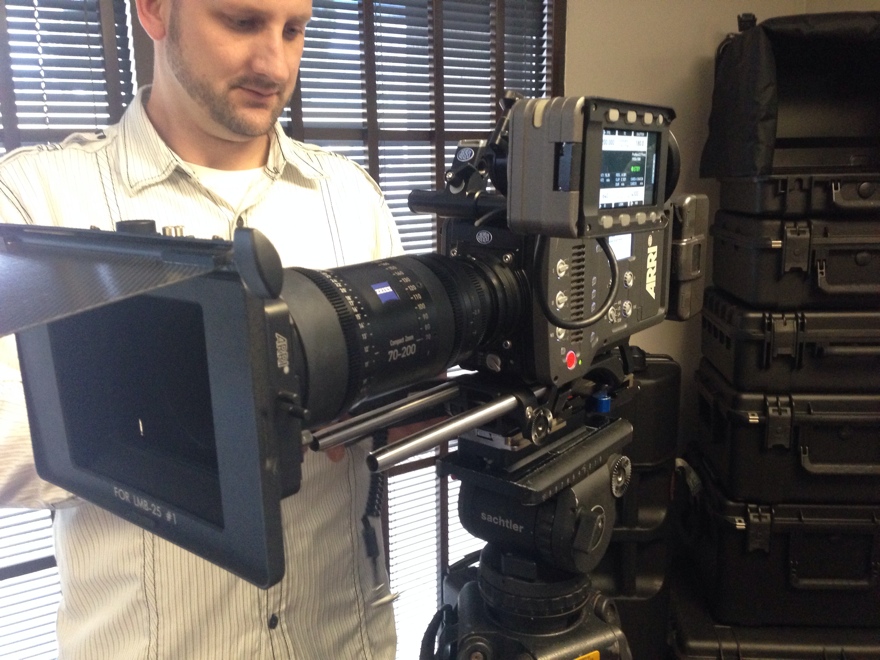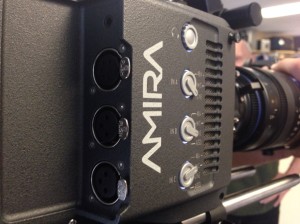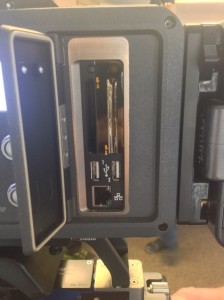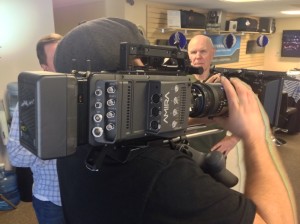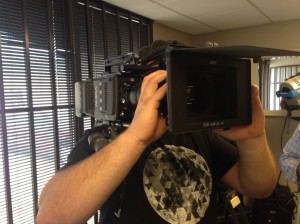The new Arri Amira is coming soon to shoots everywhere. With the base model starting at $39,999, it opens up a new audience that its bigger brother, the Alexa MSRP $80k-ish, has previously contained to bigger budgets.
I got a chance to check out a prototype version of the Amira, one of only 3 in the world (and I believe the sales guy said it was the only working prototype currently in the US).
Here’s a couple notes from the hands on experience:
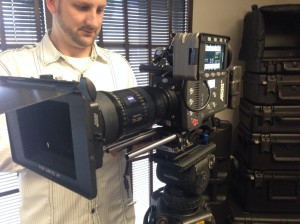 Click on any picture for larger versions
Click on any picture for larger versions
First off the form factor. HUGE deal. It comes with the option of getting a shoulder mount built into the CUSTOM dovetail setup of the bottom of the camera (the bottom is NOT standard Arri dovetail size). The balance of the camera is great… though with the Zeiss CZ 70-200 on the front and a clip on mattebox, it did feel a touch heavy. On this particular setup, the Amira had a Dionic AB battery on the back. There will be AB and V mount options for the back of the camera. The camera consumes 55Wh, roughly 5 less than the Red Epic, so you can expect a 90 Wh battery to give you approximately 90 minutes of runtime.
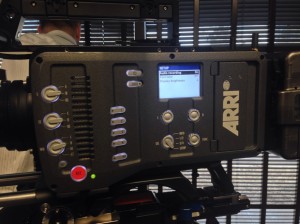 A side view of the Amira reveals a familiar Alexa-esqe simplicity. At the front left, there are 3 dials. The top dial is labeled “5”, and is a custom assignable switch with three settings. The second switch is labelled “EI” for Exposure Index, or more commonly known as ISO or Gain also with three settings. The bottom switch is labeled “WB” for Warner Brothers. HA. White balance, with three settings on the fly and an Auto Tracing (or continuous WB) option. Just to the right of the toggle switches are buttons 1-4 and an extender “2nd” button (so basically like having 8 buttons) that will be user assignable.
A side view of the Amira reveals a familiar Alexa-esqe simplicity. At the front left, there are 3 dials. The top dial is labeled “5”, and is a custom assignable switch with three settings. The second switch is labelled “EI” for Exposure Index, or more commonly known as ISO or Gain also with three settings. The bottom switch is labeled “WB” for Warner Brothers. HA. White balance, with three settings on the fly and an Auto Tracing (or continuous WB) option. Just to the right of the toggle switches are buttons 1-4 and an extender “2nd” button (so basically like having 8 buttons) that will be user assignable.
At the center of the camera is the very familiar Alexa-like menu interface, more on that in a minute. The buttons below offer basic audio levels (L and R controls) as well as a function button and a menu selector dial, offering different options to work with the on screen menu.
What’s a bit harder to notice in the picture above are the two antennas that live just before the battery connection on the back of the camera. These antennas are for wifi and bluetooth. Bluetooth will offer a wireless audio headset option, but apparently will be limited to that, and the wifi will allow a “third party app” to control the Amira via iphone or ipad. Interesting that Arri is allowing a third party to develop apps for the Amira… may make a ton of sense in the long run!
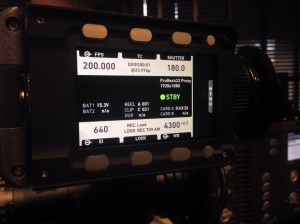 The familiar Alexa interface with FPS, shutter, EI, WB, and user settings all displayed and readily accessible with hard buttons above the screen for easy navigation. A brilliant simple design, perfect for the on-the-go shoots. The Amira operator will benefit greatly from this design.
The familiar Alexa interface with FPS, shutter, EI, WB, and user settings all displayed and readily accessible with hard buttons above the screen for easy navigation. A brilliant simple design, perfect for the on-the-go shoots. The Amira operator will benefit greatly from this design.
The audio side of the camera: Elegant and simple audio on the fly. Simple toggle switches with 3 XLR inputs.
The Amira will record to the blazing fast brand new CFAST 2.0 cards. These cards write at an astonish 450MB/s, which is needed for the Amira’s internal high speed Prores recording capabilities. There are USB connections for firmware updates as well as the new licensing options for the Amira. Customers will be able to buy a weekly “upgrade” to increase the frames per second the camera can record. The base model is locked to 100 fps, whereas the top license allows the camera to capture 200 fps.
The rear view of the camera reveals a usual host of necessary connections, including 4x SDI3G connections and 2x 12v connections.
The camera is built like a tank. Solid to the grip, a very useful top handle built in. Arri did an incredible job packing features and performance into this well designed system. I suspect we will see this camera EVERYWHERE for TV. Just in the brief time we had with the camera, a major studio in town that produces hundreds of TV shows came in, and talk of a variety of NFL and sports applications were brought up. With the ergonomics, Alexa image quality, cheaper Arri pricetag, and lightning fast prores workflow, this thing is going to make some noise.

